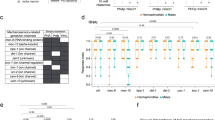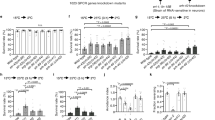Abstract
Caenorhabditis elegans senses environmental signals through ciliated sensory neurons located primarily in sensory organs in the head and tail. Cilia function as sensory receptors, and mutants with defective sensory cilia have impaired sensory perception1,2. Cilia are membrane-bound microtubule-based structures and in C. elegans are only found at the dendritic endings of sensory neurons3. Here we show that mutations that cause defects in sensory cilia or their support cells, or in sensory signal transduction, extend lifespan. Our findings imply that sensory perception regulates the lifespan of this animal, and suggest that in nature, its lifespan may be regulated by environmental cues.
This is a preview of subscription content, access via your institution
Access options
Subscribe to this journal
Receive 51 print issues and online access
$199.00 per year
only $3.90 per issue
Buy this article
- Purchase on SpringerLink
- Instant access to full article PDF
Prices may be subject to local taxes which are calculated during checkout


Similar content being viewed by others
References
Perkins,L. A., Hedgecock,E. M., Thomson,J. N. & Culotti,J. G. Mutant sensory cilia in the nematode Caenorhabditis elegans. Dev. Biol. 117, 456–487 (1986).
Peckol,E. L., Zallen,J. A., Yarrow,J. C. & Bargmann,C. I. Sensory activity affects sensory axon development in C. elegans. Development 126, 1891–1902 (1999).
White,J. G., Southgate,E., Thomson,J. N. & Brenner,S. The structure of the nervous system of the nematode C. elegans. Phil. Trans R. Soc. Lond. B 314, 1–340 (1986).
Collet,J., Spike,C. A., Lundquist,E. A., Shaw,J. E. & Herman,R. K. Analysis of osm-6, a gene that affects sensory cilium structure and sensory neuron function in Caenorhabditis elegans. Genetics 148, 187–200 (1998).
Cole,D. G. et al. Chlamydomonas kinesin-II-dependent intraflagellar transport (IFT): IFT particles contain proteins required for ciliary assembly in Caenorhabditis elegans sensory neurons. J. Cell Biol. 141, 993–1008 (1998).
Albert,P., Brown,S. & Riddle,D. Sensory control of dauer larva formation in Caenorhabditis elegans. J. Comp. Neurol. 198, 435–451 (1981).
Tabish,M., Siddiqui,Z. K., Nishikawa,K. & Siddiqui,S. S. Exclusive expression of C. elegans osm-3 kinesin gene in chemosensory neurons open to the external environment. J. Mol. Biol. 247, 377–389 (1995).
Zagotta,W. N. & Siegelbaum,S. A. Structure and function of cyclic nucleotide-gated channels. Annu. Rev. Neurosci. 19, 235–263 (1996).
Komatsu,H., Mori,I., Rhee,J. S., Akaike,N. & Ohshima,Y. Mutations in a cyclic nucleotide-gated channel lead to abnormal thermosensation and chemosensation in C. elegans. Neuron 17, 707–718 (1996).
Coburn,C. M. & Bargmann,C. I. A putative cyclic nucleotide-gated channel is required for sensory development and function in C. elegans. Neuron 17, 695–706 (1996).
Komatsu,H. et al. Functional reconstitution of a heteromeric cyclic nucleotide-gated channel of Caenorhabditis elegans in cultured cells. Brain Res. 821, 160–168 (1999).
Avery,L. & Horvitz,H. R. Pharyngeal pumping continues after laser killing of the pharyngeal nervous system of C. elegans. Neuron 3, 473–485 (1989).
Hsin,H. & Kenyon,C. Signals from the reproductive system regulate the lifespan of C. elegans. Nature 399, 362–366 (1999).
Kenyon,C., Chang,J., Gensch,E., Rudner,A. & Tabtiang,R. A C. elegans mutant that lives twice as long as wild type. Nature 366, 461–464 (1993).
Kimura,K. D., Tissenbaum,H. A., Liu,Y. & Ruvkun,G. daf-2, an insulin receptor-like gene that regulates longevity and diapause in Caenorhabditis elegans. Science 277, 942–946 (1997).
Paradis,S., Ailion,M., Toker,A., Thomas,J. H. & Ruvkun,G. A PDK1 homolog is necessary and sufficient to transduce AGE-1 PI3 kinase signals that regulate diapause in Caenorhabditis elegans. Genes Dev. 13, 1438–1452 (1999).
Larsen,P. L., Albert,P. S. & Riddle,D. L. Genes that regulate both development and longevity in Caenorhabditis elegans. Genetics 139, 1567–1583 (1995).
Dorman,J. B., Albinder,B., Shroyer,T. & Kenyon,C. The age-1 and daf-2 genes function in a common pathway to control the lifespan of Caenorhabditis elegans. Genetics 141, 1399–1406 (1995).
Ogg,S. et al. The fork head transcription factor DAF-16 transduces insulin-like metabolic and longevity signals in C. elegans. Nature 389, 994–999 (1997).
Lin,K., Dorman,J. B., Rodan,A. & Kenyon,C. daf-16: an HNF-3-forkhead family member that can function to double the life-span of Caenorhabditis elegans. Science 278, 1319–1322 (1997).
Riddle,D., Swanson,M. & Albert,P. Interacting genes in nematode dauer larva formation. Nature 290, 668–671 (1981).
Golden,J. & Riddle,D. The Caenorhabditis elegans dauer larva: developmental effects of pheromone, food, and temperature. Dev. Biol. 102, 368–378 (1984).
Vowels,J. & Thomas,J. Genetic analysis of chemosensory control of dauer formation in Caenorhabditis elegans. Genetics 130, 105–123 (1992).
Coburn,C. M., Mori,I., Ohshima,Y. & Bargmann,C. I. A cyclic nucleotide-gated channel inhibits sensory axon outgrowth in larval and adult Caenorhabditis elegans: a distinct pathway for maintenance of sensory axon structure. Development 125, 249–258 (1998).
Ailion,M., Inoue,T., Weaver,C. I., Holdcraft,R. W. & Thomas,J. H. Neurosecretory control of aging in Caenorhabditis elegans. Proc. Natl Acad. Sci. USA 96, 7394–7397 (1999).
Apfeld,J. & Kenyon,C. Cell nonautonomy of C. elegans daf-2 function in the regulation of diapause and life span. Cell 95, 199–210 (1998).
Lawless,J. F. Models and Methods for Lifetime Data (Wiley, New York, 1982).
Acknowledgements
We thank J. Whangbo, S. Alper, J. Alcedo, H. Hsin, K. Lin, L. Yang, Q. Ch'ng, A. Dillin, D. Garigan and other members of the Kenyon Lab, as well as members of Cori Bargmann's lab, for stimulating discussions. Some nematode strains were provided by the Caenorhabditis Genetics Center, which is funded by the NIH. J.A. was supported by an HHMI Predoctoral Fellowship. This work was supported by a grant from the NIA to C.K.
Author information
Authors and Affiliations
Corresponding author
Rights and permissions
About this article
Cite this article
Apfeld, J., Kenyon, C. Regulation of lifespan by sensory perception in Caenorhabditis elegans. Nature 402, 804–809 (1999). https://doi.org/10.1038/45544
Received:
Accepted:
Issue Date:
DOI: https://doi.org/10.1038/45544



